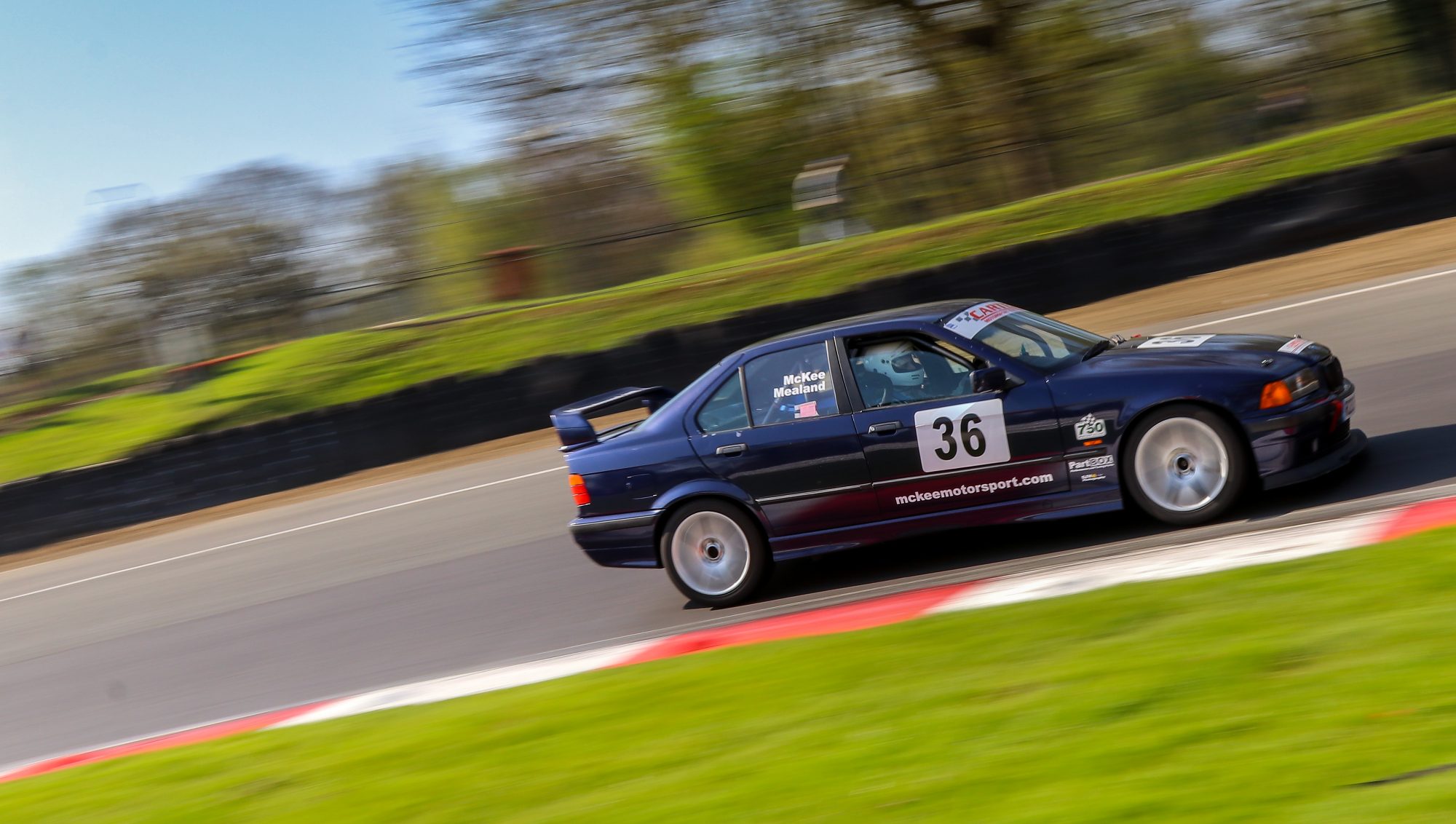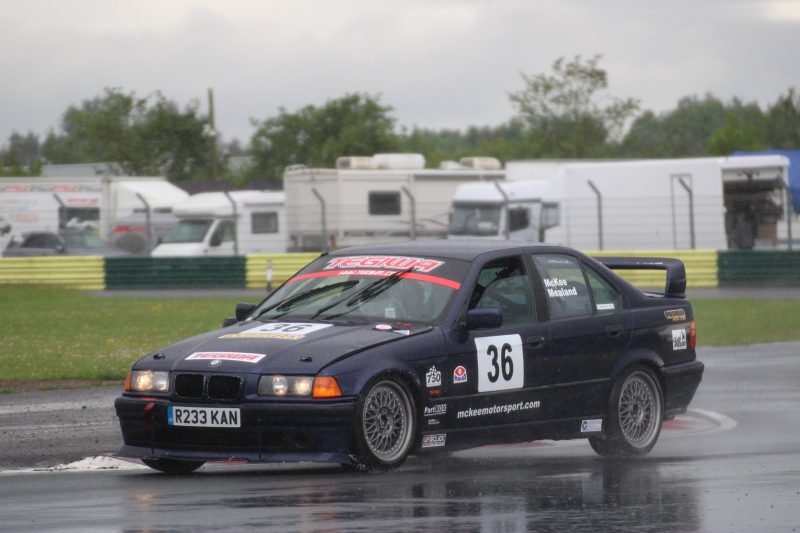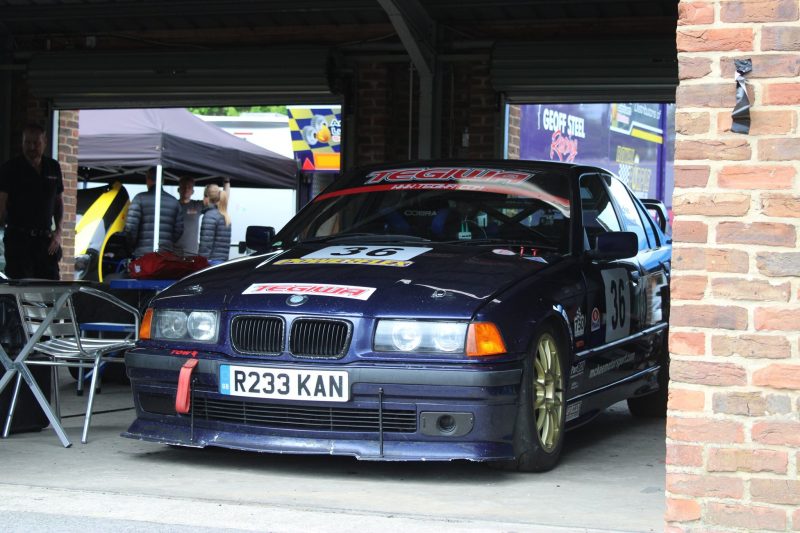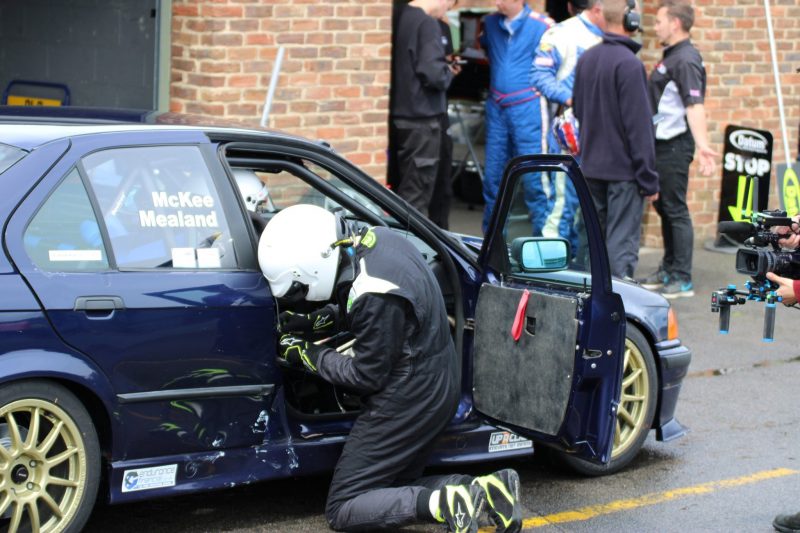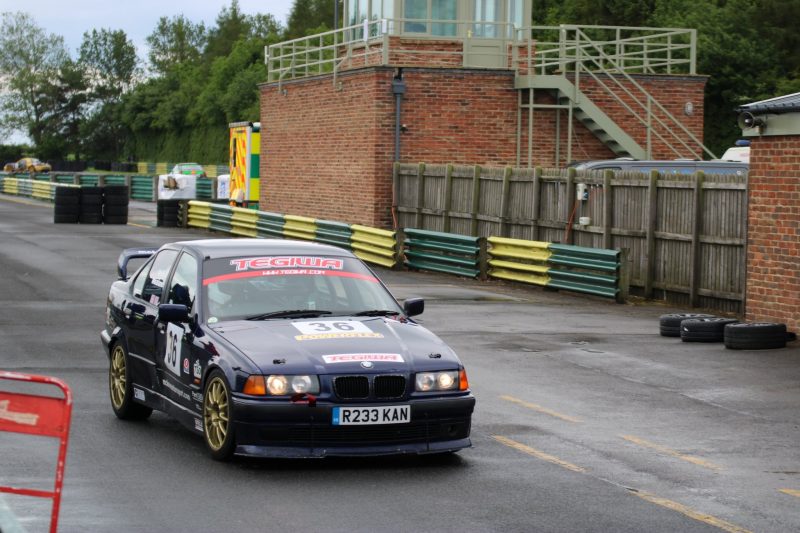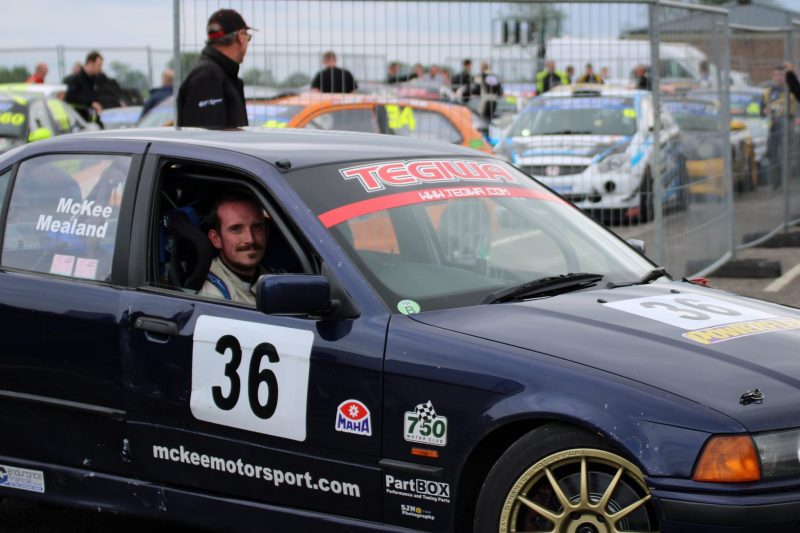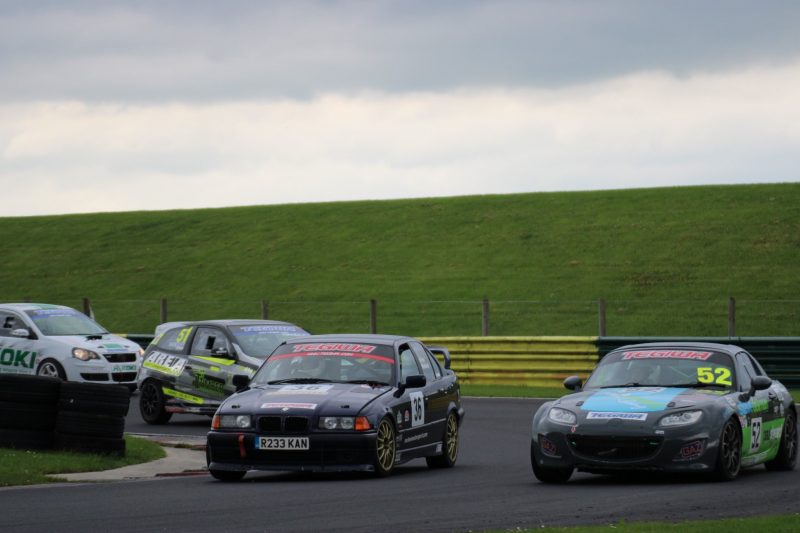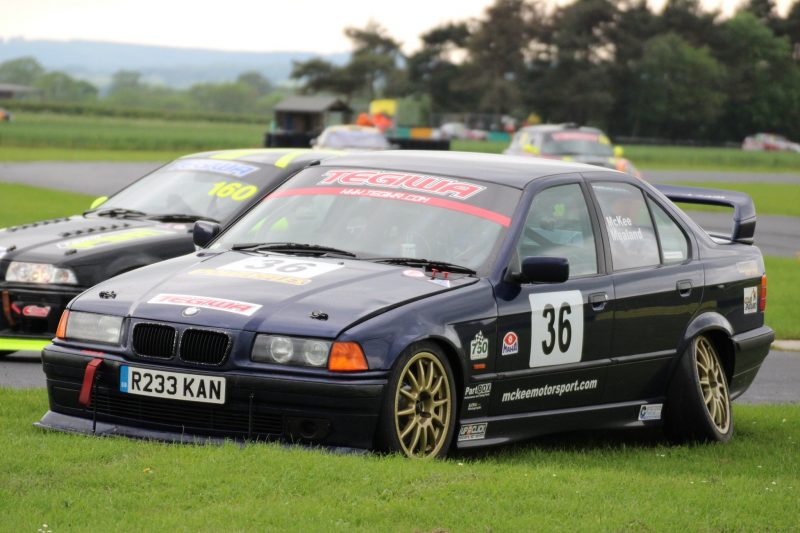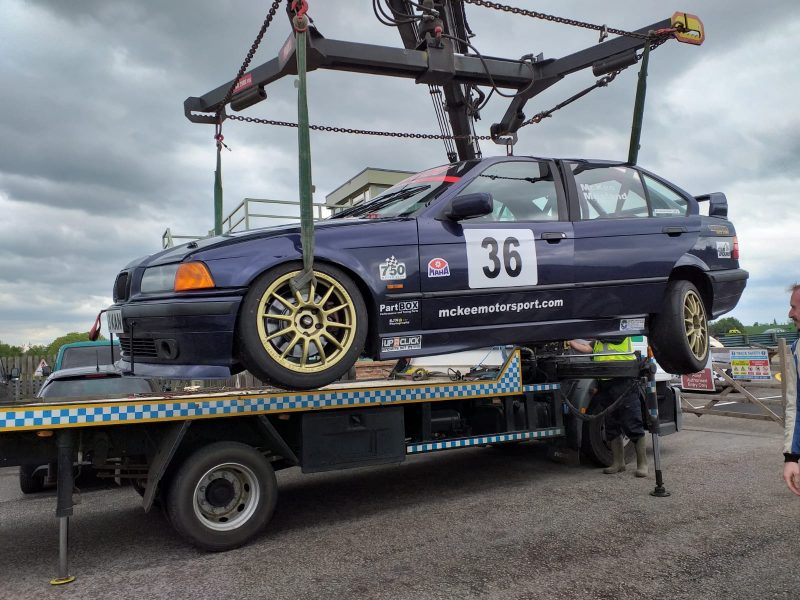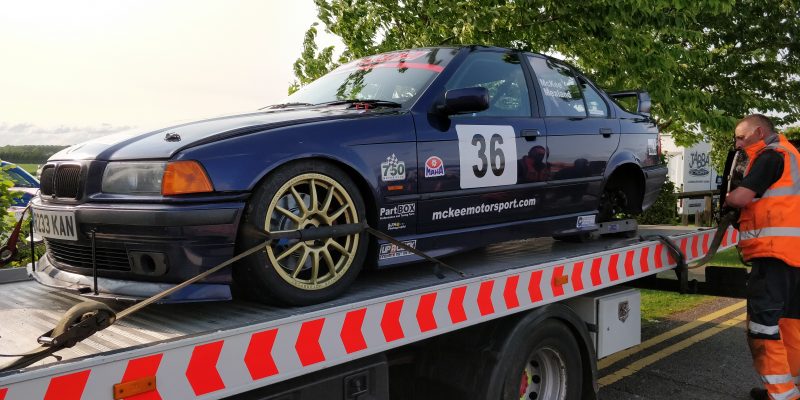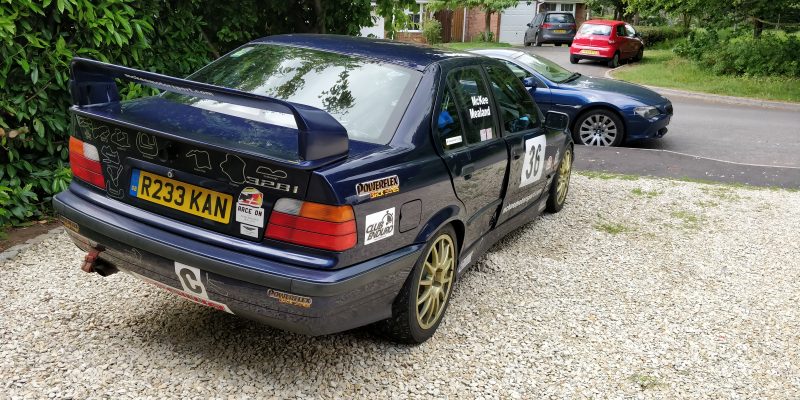“I suppose we did well to get this far..”
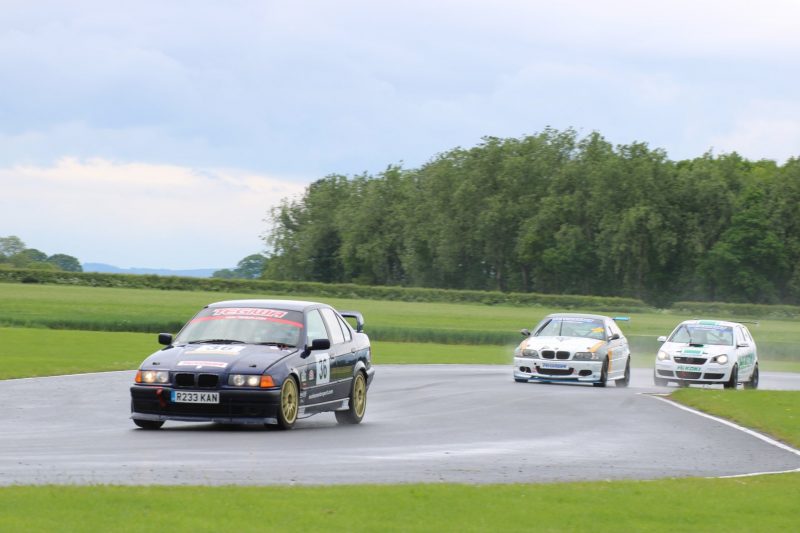 Trackside photography kindly provided by Mick Palmer of Motor Racing UK Magazine
Trackside photography kindly provided by Mick Palmer of Motor Racing UK Magazine
The next round of the Club Enduro Championship took us to Croft, a less well-known circuit 195 miles away near Darlington. I vaguely recalled the layout from playing TOCA 2 in the early 00s, but I’d never been there. Adam spectating in 2003 was the sum total of our experience on the ground! It’s a long old way up the A1(M) when you’re driving your competition car, and I’d planned to stop for dinner halfway there to stretch my legs, but actually I did the three-hour run in one hit and felt none the worse for it. It speaks volumes for the versatility of this car that even now, in full endurance-racing spec, it can still do that with ease.
Barely knowing which way Croft went, it seemed prudent to book some testing. We arrived on Friday morning to find a quaint little pit lane leading onto a circuit that looked fast, flowing and with very few textbook corners. Everything is either compound, bumpy, off-camber or all three – a simple airfield circuit this isn’t! It seems to have its own microclimate too, with our test day bringing us three seasons in one day. We found the newly laid surface remarkably good in the wet, and when it finally dried in the afternoon, we had a car that was fast, balanced and extremely satisfying. We managed to record the second-fastest time of the day for Class C cars. It’s rare to get to a stage with setup where you feel equally happy in the wet as the dry, but we’d managed it. A good job, since the forecast for race day looked likely to throw both at us.
Testing on Friday and racing on Sunday gave a rare treat – a “day off” at a circuit. While the car needed checking over and tidying up after the soaking test runs, we were generally free to soak up some racing, and what a treat 750 Motor Club had in store for us. We discovered Croft is a pretty nice spectator circuit, with banking giving us birds-eye views of 38 Locosters trying to negotiate the first chicane, the stunningly fast F1000s whose full wet laptimes outpace our dry ones, and proper eleven-tenths driving from the brilliant MG BC V8 series. These cars have to be heard to be believed – just wonderful.
Race morning dawned dry with threatening skies, but we felt content either way. We’d learnt the circuit in the full spectrum of conditions, and while we weren’t certain whether we’d been able to cure an ABS problem, we felt confident in the car. For a change, it was even looking clean and presentable before the qualfiying session!
We’d had the car on axle stands overnight to make a call on tyres in the morning. The weather looked almost stable before qualifying, so Adam drove down to assembly on dry tyres.. upon which it immediately started to bucket down good and proper. The circuit was drenched, and the focus changed. The first laps wouldn’t be any use for trying to set a time, not until Club Enduro’s capacity field of cars had circulated for long enough to dry it out. Instead Adam focused on finding where the best grip was in the wet, working to get the car around safely and smoothly to complete his laps before handing over to me to finish the session.
Unfortunately, that didn’t go quite to plan.
After his third lap, Adam came over the radio to say that he’d been hit. From the pit wall only the left-hand side of the cars can be seen, and there wasn’t any obvious damage. He reported it was driving OK, so he stayed out and kept punching in faster laptimes as the circuit dried. After three more, he came in to hand the car over to me. I found a very bent driver’s door that was a struggle to open, but the rush of a mid-session driver handover was no time for close inspection. I strapped in and went out to try and put us on pole position once again.
The car felt unbalanced, requiring some left steering lock to keep it straight, and considerably more keen to go right than it was to turn left.. but qualifying is a short session and only the laptime counts. Under those circumstances it’s possible to force your brain to ignore most issues, so as I’d done at Donington, I switched off my mechanical sympathy and pushed as far as I could. The lap times tumbled as the circuit improved and through the pit board Mum and Emily told me the story: 36 P3, 36 P2, and finally 36 P1. We were the fastest of the fourteen Class C cars, but in the dying minutes of the session I knew there was far more time still out there.
Finally I overstepped the mark into Clervaux, Croft’s unforgiving first corner. You hit it in fourth gear, and with gravel on the outside your instinct is to clip early – but the inside kerb is enormous, and there’s a savage dip right in the apex. It’s the toughest test of dampers I’ve found on any circuit, and this time I asked too much and had a big sideways moment. Remembering we had an endurance race starting in an hour and a half, I backed off and brought the car back to the pits. It was a shame to see we slipped to fifth place by the end of the session, but it was the right call to resist pushing too hard.
It wasn’t until I got out in parc fermé that I saw what the contact Adam reported had done to the car. It wasn’t just the doors – the entire bodyshell had caved in as far as the rollcage. The B-pillar was hard against the cage, the sill rail was a crumpled mess, and the floor was rippled up. The body was visibly bent around the point of impact. It was the kind of damage you only get in a serious shunt, so the footage from our camera went straight to the stewards. I shuddered to think what would have happened without the rollcage, then started to wonder if this car was even raceable.
We later heard that the stewards found Adam at no fault for the collision. The other driver involved was excluded from qualifying and their licence endorsed with four penalty points.
Just our luck that the schedule was another short gap between qualifying and race start – we had only an hour before we would be called to the assembly area. The shell looked like it could be terminally damaged, but with no reserves left on the entry list and no refund for withdrawing, we had to try and race it. Priority one was to get the driver’s door working properly, so that marshals would be able to extract us from the car in the event of an accident. Thankfully it did reseat and could be operated from inside or out. The rear door was “persuaded” back into an aperture that was no longer big enough for it, the hole torn in the floor was patched, the tank was brimmed with fuel, and we had time for no more than a wheel torque check before it was showtime.
But racing is an amazing thing. There I sat strapped into a car that had been five years in the making, with blood, sweat and yes, a few tears poured into the endless development that got it from a tired repmobile to a race winner. I knew she’d been dealt a serious blow and I had no idea whether she could ever be repaired. I’d never considered looking past this car, but now it could be the end of the road. Yet when I pulled around the hairpin for the rolling start among the biggest grid of cars Croft had ever seen, the lights went out, I opened the throttle, and everything else fell away. All that was left was the desire to win, the almost instinctive control of the car, the constant judgement of the drivers alongside and ahead, and hunting for any gap or any mistake I could use to get in front.
I passed five cars in the opening lap, and it felt absolutely incredible. There is nothing like pushing a car right to the edge of the envelope, inches from another, and winning through. Here’s the start of the race:
Crushingly, it wasn’t to last. There was a brief safety car period during which a lot of rain fell, but when we resumed racing there was obviously a problem with the car. I couldn’t pinpoint it at first, there was just an instability somewhere, and it felt like the oversteer to the right had worsened. I subconsciously started to back off, losing third place to the #68 Mazda MX-5 of Darren and James Kell.
On the exit of Tower corner I realised this was serious and I was going to have to pit, just 12 minutes into the race. But this was halfway around the lap, and I had over a mile to nurse the car back. Even at reduced pace, a vibration rapidly became what felt like a shredded rear tyre, with the car crabbing right and dragging heavily. I got as far as the Complex, three corners to go, before a heart-stopping bang shook the whole car. I immediately had no drive and it was obvious that at least one wheel had completely locked. I could hear the tyre screaming against the tarmac, and the drag was huge. I tried to use the momentum to get out of the way, but in the end only made it a few feet off the circuit into the grass. After trying in vain to move the car, I had to abandon it.
The moment I looked back, my hopes sank. This wasn’t a damaged tyre, it was a complete collapse of suspension or wheel hub. There was no prospect of getting that car back out into the three-hour race.
Croft’s excellent marshalling and recovery team got the car off the circuit and sympathetically lifted back to the paddock where I could work on it. On removing the wheel, which was only kept tethered to the car by its brake disc being trapped in the caliper, we found the driveshaft end had sheared off. The huge nut on the end of that shaft holds the wheel hub together, so with it gone, the bearing had collapsed and the wheel came completely free of its mounting. It looked like the car had been running on a cracked shaft which had progressively bitten through until complete failure. A cracked shaft such as you might expect if your car had been thrown bodily across a racetrack by a collision two hours previous…
It really hurt to see the car lifted onto a truck for the first time in my entire ownership. Reliability had been so key in everything we’d done, and the car had proven itself time and again, so it felt absurd to retire with two and three-quarter hours’ racing still to go. It was small consolation that the failure didn’t seem to be down to our preparation or our driving. We had little to do but watch the more fortunate drivers still racing, load all our equipment back into the stricken car, and wonder about how to get it home.
The marshalling team at Croft went above and beyond to help us with that. They put us in touch with a local recovery firm and even tracked me down in the paddock later in the day to make sure I’d been able to get something arranged. At not-insignificant cost – even in the context of endurance racing! – I had, and by 10pm that evening the car was home.
What happens next for #36?
Well, in the cold light of Monday morning, the car looked no prettier. The further I inspected the more damage I found, and the bodyshell looks well beyond what you’d consider saving on a road car. Motorsport is different – not only in the value of the car, but also in the effort required to transplant everything to another shell, with welded rollcage feet and plumbed-in fire extinguishers to name just two jobs requiring a lot of work. Saving this car could still be the most cost-effective way to get racing again, and if there’s any chance she can live on, I want to take it. Work continues now to rebuild the rear left corner and get the car driveable, so it can be properly assessed and a decision taken. In the meantime we’ve had to withdraw from the next two rounds at Spa-Francorchamps, a real disappointment that – along with our failure to finish at Croft – also puts us out of contention for the championship.
I’ll keep you updated as I try to bring the car back.
Sam
